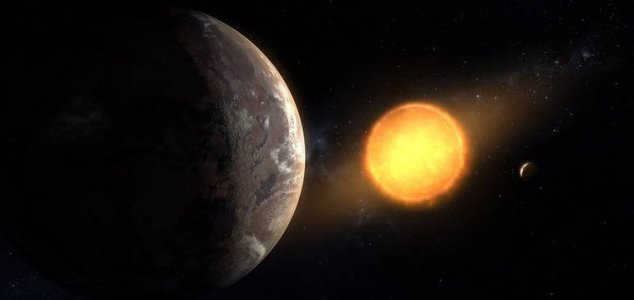Space & Astronomy
April 17, 2020 · 6 comments
6 comments

An artist's impression of Kepler-1649c. Image Credit: NASA / Ames Research Center / Daniel Rutter
Now thanks to new computer software developed by researchers at NASA's Ames Research Center, another of Kepler's discoveries has come to light - one that had been hidden away deep in the data.
The planet, which is known as Kepler-1649c, is situated 300 light years away and is 1.06 times the size of the Earth - making it the most similar to our own planet of any Kepler world found to date.
Although Kepler-1649c is situated around a red dwarf star (which is cooler and dimmer than the Sun), it orbits close enough for there to be enough heat to make liquid water on its surface possible.
That said, we don't know its mass nor what kind of atmosphere it may have, so it's impossible to say right now just how likely it is to be habitable.
Kepler-1649c, like many other Earth-like exoplanets, will be a prime candidate for further study once NASA's long-awaited James Webb Space Telescope launches within the next few years.
"This intriguing, distant world gives us even greater hope that a second Earth lies among the stars, waiting to be found," said Thomas Zurbuchen, associate administrator of NASA's Science Mission Directorate in Washington.
Source: Extreme Tech | Comments (6)
Kepler data reveals hidden Earth-like exoplanet
By T.K. RandallApril 17, 2020 ·
 6 comments
6 comments
An artist's impression of Kepler-1649c. Image Credit: NASA / Ames Research Center / Daniel Rutter
Scientists have discovered one of the most Earth-like extrasolar worlds ever seen and they almost missed it.
The hunt for alien worlds in distant star systems has been going from strength to strength in recent years due in no small part to NASA's now-retired Kepler Space Telescope.Now thanks to new computer software developed by researchers at NASA's Ames Research Center, another of Kepler's discoveries has come to light - one that had been hidden away deep in the data.
The planet, which is known as Kepler-1649c, is situated 300 light years away and is 1.06 times the size of the Earth - making it the most similar to our own planet of any Kepler world found to date.
That said, we don't know its mass nor what kind of atmosphere it may have, so it's impossible to say right now just how likely it is to be habitable.
Kepler-1649c, like many other Earth-like exoplanets, will be a prime candidate for further study once NASA's long-awaited James Webb Space Telescope launches within the next few years.
"This intriguing, distant world gives us even greater hope that a second Earth lies among the stars, waiting to be found," said Thomas Zurbuchen, associate administrator of NASA's Science Mission Directorate in Washington.
Source: Extreme Tech | Comments (6)

The Unexplained Mysteries
Book of Weird News
AVAILABLE NOW
Take a walk on the weird side with this compilation of some of the weirdest stories ever to grace the pages of a newspaper.
Click here to learn more

Support us on Patreon
BONUS CONTENTFor less than the cost of a cup of coffee, you can gain access to a wide range of exclusive perks including our popular 'Lost Ghost Stories' series.
Click here to learn more
United States and the Americas
Israel, Palestine and the Middle-East
Ancient Mysteries and Alternative History
Spirituality, Religion and Beliefs
Total Posts: 7,613,399 Topics: 316,759 Members: 201,928
Not a member yet ? Click here to join - registration is free and only takes a moment!
Not a member yet ? Click here to join - registration is free and only takes a moment!



























Please Login or Register to post a comment.